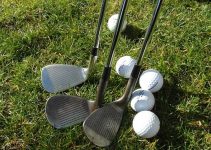Golfstead is reader-supported. When you buy through links on the site, we may earn an affiliate commission at no extra cost to you. Our affiliations include, but are not limited to, the eBay Partner Network and Amazon Associates.

Have you ever seen a pro golfer on television, or any good golfer for that matter, hit a shot into the green that ended up spinning back like a rocket?
This is more likely to happen in wet conditions, but wouldn’t you like to be able to replicate this even a little bit? How exactly do you put spin on the ball — backspin, to be more specific?
In this article, we’ll go over how to spin the golf ball and give you the best techniques you can start applying right now so you can improve your control coming into the greens. We’ll also discuss what backspin involves and situations on the golf course that call for it.
When To Spin The Ball
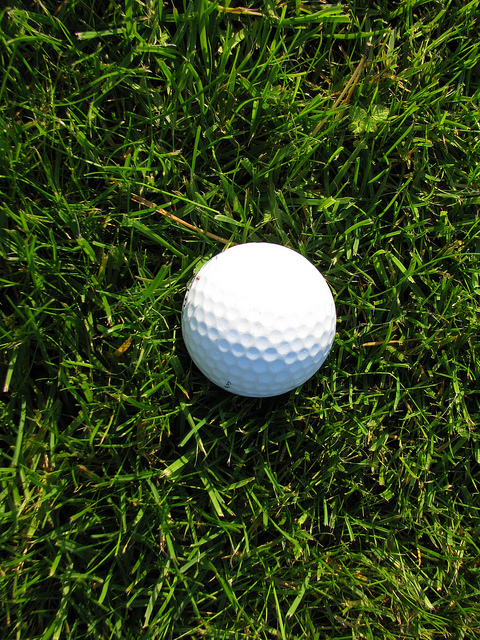
Being able to generate, much less control, the amount of spin you put on a golf ball is actually something that most amateurs, and even some seasoned golfers, have a lot of trouble with.
It comes with experience and a certain degree of proficiency. It requires you to know how to make solid, “ball-first” contact with the golf ball, and do it with enough speed for the grooves to do the work.
There are, of course, many instances where it would be quite useful to be able to put spin the ball. Here are some of them:
- you have a tight lie, with rough, a bunker or another obstacle between you and the flag, and you need to stop the ball quickly once it lands on the green
- the pin is on the lower level of a sloped green and you want to run the ball backwards down the slope with the help of spin
- the green is narrow from back to front, so you don’t have much room for the ball to roll once it lands on the green
Often times, however, golfers don’t intend to put backspin on the ball or they apply too much spin. In cases like this, the ball might roll past the hole and end up well short. Thus, in many cases, spin can hurt rather than help.
How is backspin generated?
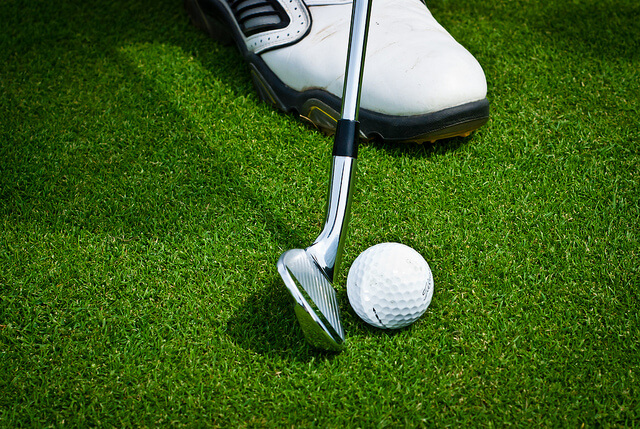
Backspin (spinning away from the direction of the target) occurs when the clubface makes contact with the ball and the grooves on the face of the club “grab” the ball, imparting a spin before it takes off.
There are several key factors which affect how much the ball spins, and they are:
1. The effective loft of the clubface at impact.
The higher the effective loft is, the closer the clubface becomes to pointing directly up towards zenith, and the easier it is for the grooves to grab the ball and “roll it up” the face.
The effective loft of the clubface at impact is also known as dynamic loft, and it’s a very important factor in generating spin.
For example, it’s much easier to impart backspin on the ball with a 9-iron as compared with a 3-iron. On the other hand, you get relatively little spin with a driver.
2. How clean the strike is.
If there is grass, mud, sand or any other matter between the clubface and the ball at impact, some or all of the grooves won’t be able to make contact with the ball to create spin.
This is why you generally cannot apply much spin on the ball out of the rough — grass gets between the clubface and the ball.
This is also why you generally want to hit the ball before the ground in order to get solid spin. If you hit the ground first, dirt, grass, and other material will interfere with the ball’s contact with the grooves.
3. Clubhead speed.
It is important to accelerate through the ball if you want a good backspin.
The faster the face impacts the ball, the more time the grooves have to grab the ball and create spin before the ball “rebounds” or “rockets” off the face.
It is widely believed that a steep club path coming into the ball, or a greater angle of attack, affects the spin of the ball. However, there exists evidence, particularly from TrackMan, that indicates this is not necessarily true.
In particular, what ends up happening when you hit “down” on the ball with a steep angle of attack is that your hands move ahead of the clubhead in the downswing, which delofts the face. This reduces dynamic loft and hence reduces spin.
This is why we don’t recommend trying to steepen your angle of attack in order to generate more spin, and that’s not even mentioning the fact that a steeper swing can also have various negative side effects on your ballstriking.
What can you do to spin the ball?
Based on what we mentioned above, you should do the following if you want to maximize the amount of backspin you generate:
1. Use a golf ball conducive to spinning.
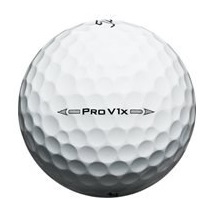
Use a quality golf ball with a high spin rating, like the Titleist Pro V1/V1x.
Generally speaking, golf balls with urethane covers tend to spin more than balls with ionomer covers. You can check out our recommendations for the best golf balls here.
2. Use a higher-lofted club or open your clubface.
The shorter clubs — 7, 8, 9 irons, and wedges — will naturally produce more spin than longer clubs.
You can alternatively open your clubface which will increase its effective loft. If you do, just be sure to make the necessary adjustments in your alignment as an open clubface will tend to send the ball to the right.
3. Hit from a tight, clean lie.
As touched on above, you can’t expect to spin the ball much out of the rough, especially if it’s sitting down or the grass is long.
Hit from a lie like the fairway, fringe or even a bunker, where you can get the leading edge underneath the ball with no impediments.
4. Keep the face clean and hit the ball first.
Make sure your clubface is clean, hit the ball solidly, and take the divot after the ball. This will allow the grooves of the face to make full contact with the ball.
Many amateurs often neglect to clean their clubs even when the grooves are caked with dirt; what they likely don’t realize is that they’re either partially or completely preventing the club from creating backspin.
5. Use the right clubs.
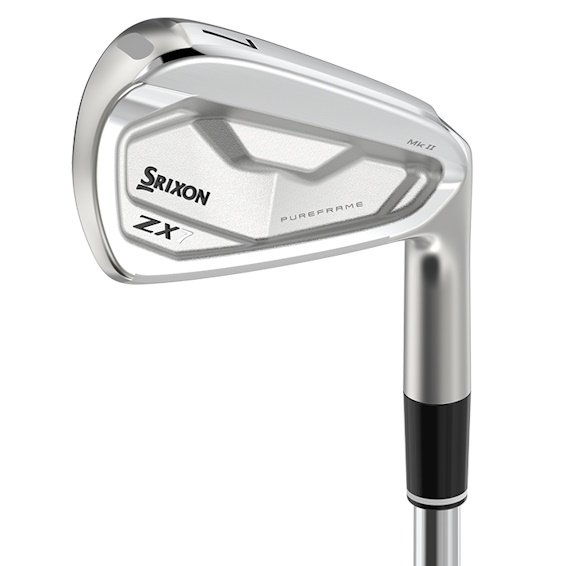
The clubs you’re using can make a big difference as to how much spin you generate.
When it comes to drivers and woods, avoid models that are marketed as “low spin”. These clubs typically shift the center of gravity (CG) forward. For maximum spin generation, look for models designed to be forgiving with a CG that is shifted back, like the PING G425 MAX.
When it comes to irons, avoid models that are marketed as “distance irons” with strong lofts. Players irons with slimmer profiles are usually designed to generate more spin for capable golfers.
6. Accelerate through the ball.
You should swing through the ball at a good speed. If you feel that you’re swinging too slow and it may be hindering your ability to put spin on the ball, take a look at our speed article for some clarity and tips.
Note that the firmness of the golf course typically determines how far balls spin back.
On wet grass (fairways, greens), there is less rollout and most of the spin goes into bringing the ball back. In other words, the result of spin is much more obvious in soft conditions.
A Note On Sidespin
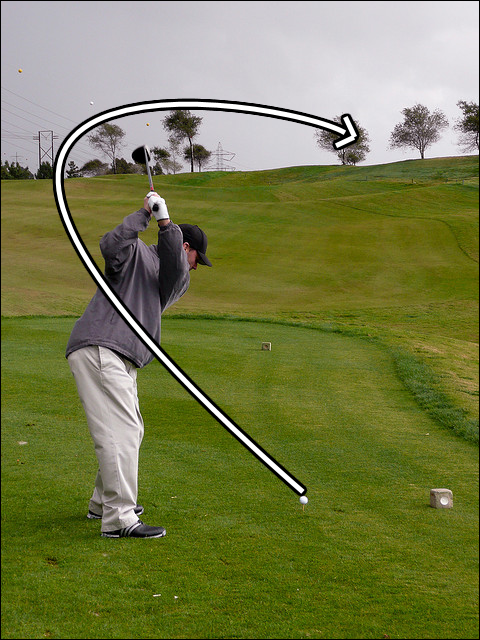
This article mainly focuses on generating backspin, which is just one type of spin.
Sidespin, in contrast to backspin, refers to the ball spinning (or rotating) horizontally to the left or right as it flies through the air. It occurs when the clubface is not square relative to the swing path at impact.
Sidespin results in a shot that curves left or right:
- draw (right to left): the face is closed at impact relative to the swing path
- fade (left to right): the face is open at impact relative to the swing path
The more the face is open or closed at impact, the more pronounced the curve, which could even lead to a nasty hook or slice.
There are many situations where golfers might want to impart sidespin onto the ball and create a curved flight. To learn more about sidespin, check out our articles on hitting a draw, hitting the ball straight, and eliminating a slice.
Conclusion
Spinning the golf ball isn’t necessarily difficult, but it does require a certain command over your golf swing and your ballstriking.
At the end of the day, the biggest things that are going to help you generate spin are using a higher-lofted club, coming into the ball with sufficient clubhead speed, and making solid, ball-first contact.
Hopefully, after reading and applying the information and guidance given here, you’ll be well on your way to developing a firm control of the spin on your golf ball.
Remember that having quality equipment will not only help you generate backspin, but also help lift up your entire game.
Thanks for reading. How much can you control the spin you put on your golf ball? Feel free to share your story in the comments below.

